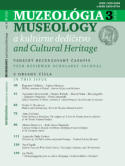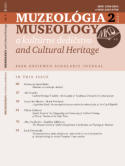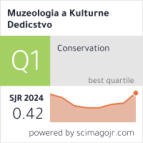

MUZEOLÓGIA
MUSEOLOGY
a kultúrne dedičstvo
and Cultural Heritage

News
Journal Muzeológia a
kultúrne dedičstvo -
Museology and Cultural
Heritage:
SJR 2024: 0,424 (Q1)
Museology SJR rank: 8/83 (Q1) Conservation SJR rank: 11/103 (Q1)JIF WoS 2023: 0,6
JCI WoS 2023: 1,28, Q1 ESCI: 49/411 (Q1)New issue
Muzeológia a kultúrne
dedičstvo 1/2025
online New volume Studia Museologica Slovaca, vol. 8 (2024) online New volume Populačné štúdie Slovenska 17 (2024) onlineNew book
P. Tišliar (ed.). Osobnosti uměleckoprůmyslového muzejnictví (2025). online
Contents 2/2021
Title: Museums as Landscape Activists
Abstract: The article discusses the issue of the “extended museum”, raising questions about how museums become active actors in
current topical discussions on the shape of cities, what their role is in the processes of city management and how this engagement in
external spaces affects the overall mission of museums. The point of reference is the ICOM Resolution on the responsibility of
museums towards landscape adopted in 2016, which offered museums legitimacy in taking actions with regard to their environment,
beyond museum walls. On the grounds of four case studies of Polish museums I present strategies whereby relations between the
museum, authorities and communities are negotiated (regarding the protection of post-industrial and Second World War heritage, the
contextualisation of socialist heritage and the struggle for greenery).
Author: Katarzyna Jagodzińska
Publication order reference: Jagiellonian University, Faculty of International and Political Studies, Institute of European Studies, ul.
Władysława Reymonta 4, 30-059 Kraków, Poland, email: katarzyna.jagodzinska@uj.edu.pl, ORCID: 0000-0003-2290-410X
Source: Muzeológia a kultúrne dedičstvo, year: 2021, vol.: 9, number: 2, pages: 5-26.
Key words: extended museum, museum activism, landscape, ICOM Resolution
Language: English
online full-text PDF
DOI: 10.46284/mkd.2021.9.2.1
Title: Cultural Heritage Viability: An Example of Traditional Transport in Central Europe
Abstract: This paper focuses on traditional transport as a form of cultural heritage in Central Europe, looking at the modes of
transport that are still viable today as a part of people’s lives and livelihoods, as well as strategies to ensure their survival. The
importance of preserving the original purpose of traditional transport modes, as well as their acquisition of new functions in the modern
era, are examined in the context of the sustainability and viability of cultural heritage. The article also highlights crucial role of
promoting the visibility of cultural phenomena to the public in encouraging their protection and ongoing sustainability. It also draws
attention to some less positive examples of how forms of traditional transport are currently presented, examining approaches that may
lead to the alteration of traditions and the construction of distorted images of cultural heritage. In the conclusion, I propose
distinguishing between forms of traditional transport that continue to maintain people’s livelihoods or generate entertainment, and
forms which are merely reconstructions of traditional phenomena, intended only as imitations to recall the past.
Author: Aleš Smrčka
Publication order reference: Czech Academy of Sciences, Institute of Ethnology, Department of Critical Heritage Studies, Na
Florenci 3, 110 00 Prague, Czech Republic, e-mail: smrcka@eu.cas.cz, ORCID: 0000-0002-7279-8053
Source: Muzeológia a kultúrne dedičstvo, year: 2021, vol.: 9, number: 2, pages: 27-44.
Keywords: cultural heritage viability; traditional transport; intangible cultural heritage (ICH); UNESCO; Central Europe
Language: English
online full-text PDF
DOI: 10.46284/mkd.2021.9.2.2
Title: Acquisition Fund: An unrecognised treasure within the cultural policy of the Czech Republic
Abstract: The paper elaborates on the Acquisition Fund for Contemporary Art established in 2017 in the Czech Republic by the
Ministry of Culture. Paradoxically, this fund is perceived both positively and negatively by various institutions. On the positive side,
from the year 2017 to 2019, the fund has allocated 41,257,888 CZK (1,517,753 EUR) for the purchase of 287 artworks by 29
institutions. On the negative side, only 29 out of 218 eligible institutions have applied for support from the fund during the three years
of the fund’s existence. This low application rate is attributed partly to the time consuming and complicated administration of the
application for support, and partly to apprehension from some institutions regarding the likelihood of the actual realisation of the
receipt of financial support. In turn, due to this low application rate, the institutions that have applied have had a high probability of
receiving funding. The paper sheds new light on the lack of financing for acquisition in art institutions and opens the question of the
effectiveness of the Acquisition Fund in the Czech Republic.
Authors: Lucia Horňáková, Marek Prokůpek
Publication order reference: Prague University of Economics and Business, Department of Arts Management, Czech Republic, e-
mail: lucia.hornakova@vse.cz, ORCID: 0000-0003-3734-7756, e-mail: marek.prokupek@vse.cz, ORCID: 0000-0003-4564-8962
Source: Muzeológia a kultúrne dedičstvo, year: 2021, vol.: 9, number: 2, pages: 45-59.
Keywords: acquisitions, contemporary art, acquisition fund, art museum, art collecting
Language: English
online full-text PDF
DOI: 10.46284/mkd.2021.9.2.3
In Practice
Title: Specific Forms of the Safeguarding and Showcasing of Cultural Heritage as Part of Tourism in
the High Tatras
Abstract: This study describes a variety of approaches to communication by museums involved in cultural heritage exchange. It
focuses on the High Tatras region, which is the most important centre of tourism in Slovakia. It also looks at the specifics of how
tourism developed in the region.
The data was collected over a multi-year series of ethnological field research trips, and primarily conducted by means of structured
interviews, oral histories and participatory observation. The paper concentrates on shifts in the area of museum communication, from
the classical interpretative approach towards exhibitions that present their subject matter in a more flexible way, with a focus on
emotional experience.
The article aims to use some chosen case studies of small, independent museums and galleries from the town of Vysoké Tatry, in the
High Tatras, to highlight the importance of sustainability, especially in terms of the growth of tourism.
Author: Zdena Krišková
Publication order reference: Matej Bel University, Faculty of Arts, Department of Social Studies and Ethnology, Tajovského 40, 974
01 Banská Bystrica, Slovakia, e-mail: zdena.kriskova@umb.sk, ORCID: 0000-0003-1977-3145
Source: Muzeológia a kultúrne dedičstvo, year: 2021, vol.: 9, number: 2, pages: 61-77.
Keywords: museum, tourism, cultural tourism, cultural heritage
Language: English
online full-text PDF
DOI: 10.46284/mkd.2021.9.2.4
Title: The Museum System of Modern Kazakhstan: Classification and Typology of Museums
Abstract: This article discusses the museum system of modern Kazakhstan and offers, for the first time ever, a classification and
typology of the country’s museums.
In recent years in independent Kazakhstan, on the basis of the Soviet system, a modern museum network has been formed which
currently lists 250 museums. Among them are 17 national-level museums, 54 at the regional level, 73 at the provincial level, 103
branches of regional- and district-level museums and four private museums.
The purpose of this article is to analyse the museum system of modern Kazakhstan and develop a classification and typology of the
country’s museums.In the course of the study, conducted in 2017–2018, data was collected on the activities of museums at the
national, regional and district levels over the past seven years. From the results of this investigation, the museums of Kazakhstan
were systematized according to the subject or topic of the museum (e.g. history, art, scientific), its affiliation (national, regional district),
and by size, measured by number of employees.
Authors: Abay Satubaldin, Kunikey Sakhiyeva
Publication order reference: National Museum of the Republic of Kazakhstan , Tauelsyzdyk Avenue, 54, 010000 Nur-Sultan,
Republic of Kazakhstan, e-mail: abaykarimtaevich@mail.ru, ORCID: 0000-0002-4511-9422, e-mail: kunikey.sakhiyeva@gmail.com,
ORCID: 0000-0002-8196-1772
Source: Muzeológia a kultúrne dedičstvo, year: 2021, vol.: 9, number: 2, pages: 79-89.
Keywords: museum sector, museums activities, museums of the Republic of Kazakhstan, excursions, visitors
Language: English
online full-text PDF
DOI: 10.46284/mkd.2021.9.2.5
Title: The practical use of police databases of stolen works of art in the protection of national
heritage in selected European Union countries
Abstract: The effectiveness in the protection of works of art constituting national heritage depends on many factors. These factors
include, among other things, binding legal regulations within the scope of the protection of works of art and national heritage sites,
good organisation of police forces specialising in this type of activities and cooperation in this field with other state and local
government institutions and the wider society. Apart from police officers’ commitment and experience, police databases that are
dedicated to works of art also play an extremely important role. This article presents selected police databases devoted to works of art
that are currently used by police organisations and the role of these databases in protecting national heritage in selected European
Union countries. The content of the article was prepared on the basis of the analysis of literature, existing legislation and interviews
with police officers and experts. The information obtained during the interviews was subjected to qualitative analysis and presented in
a descriptive version.
Author: Jacek Dworzecki
Publication order reference: Military University of the Land Forces in Wroclaw, Poland & Academy of the Police Force in Bratislava,
Slovakia, e-mail: jacekdworzecki@o2.pl , ORCID: 0000-0002-9357-5713
Source: Muzeológia a kultúrne dedičstvo, year: 2021, vol.: 9, number: 2, pages: 91-101.
Keywords: works of art, databases, protection of national heritage, European Union
Language: English
online full-text PDF
DOI: 10.46284/mkd.2021.9.2.6
Articles (Abstracts)

Full-text version
DOI:10.46284/mkd.2021.9.2.0
ISSN 1339-2204
eISSN 2453-9759
Vol. 9 (2021), No. Is. 2



























